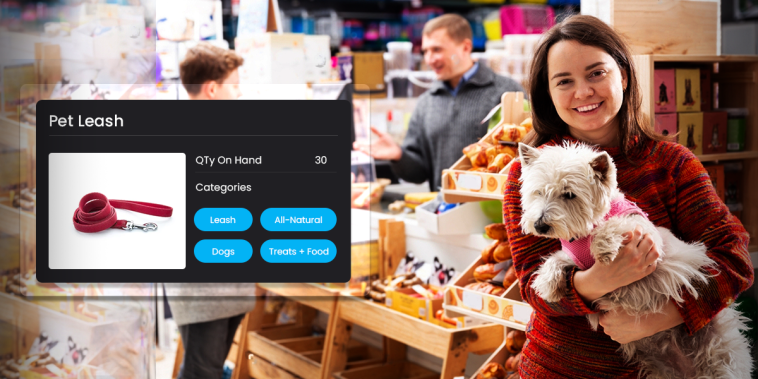How can pet shop retailers find an edge that will grow sales? Here’s a hint: POS data.
That’s right. POS reporting data offers business owners numerous insights that they can use to A) better serve customers, B) improve their marketing efforts, and C) reduce waste.
These factors combine to help pet shop owners improve their bottom lines. How? This starts with the types of data a pet store POS system collects:
- Customer data – The types of pet products customers buy and buying patterns
- Transactional data – Reporting on sales at the transaction level
- Inventory data – Inventory data helps retailers reduce out-of-stocks, improve inventory efficiency, and reduce waste
- Product data – Pet supply products that are selling (and those that aren’t)
Pet stores can use this data to find opportunities to improve and get better. Looking for some tips to get started? This guide covers the most useful POS data for pet shops and provides tips for using that data to boost revenue.
How to Use POS Data in a Pet Store
POS data is full of insights, and using it, retailers can use it to make data-driven business decisions. This data helps retailers make marketing decisions (e.g. what types of promotions are best), improve operational efficiency, and identity trends to keep up with.
Here’s a look at how all data types (customer, inventory, product and sales data) can be used to boost store sales:
Customer Data
pet store point of sale offers the ability to launch a loyalty program. This allows the business to gather customer information and learn about their buying habits Some data a pet shop loyalty program will help you understand include:
- Average spending per visit
- Average no. of visits every month
- Favorite products (frequently purchased by them)
- Order history
This data helps store owners to better understand customer demographics. For example, if a store’s clientele prefers higher-end dog food, they can adjust inventory and promotions to suit their customers’ tastes. This data also offer insights to offer personalized promotions, allowing the business to offer coupons for a customer’s favorite brands, for example.
Not only does a loyalty program offer great data, it’s also an effective strategy for driving repeat visits and engaging your audience. You can use SMS or email marketing, for example, to engage your rewards audience and bring them back to your store.
Inventory Data
Inventory control forms a crucial part of managing any retail business. A point-of-sale system gathers metrics about your inventory, and you can use this information to improve customer experiences.
For example, POS data shows how inventory levels change whenever customers buy products or complete the checkout process. Getting real-time inventory updates gives retailers an idea about items low in stock and items that are selling fast.
This data helps retailers to maintain sufficient stock levels, thereby avoiding out-of-stock issues or overstock issues (and inventory loss).
Maintaining sufficient inventory levels helps create a positive impression of your store and helps maintain sales levels every season and throughout the year. Inventory data also helps pet shops improve inventory efficiency, which frees up cash flows. For example, advanced systems use data to predict reordering thresholds, allowing the business to automate inventory ordering (and getting more efficient in the process).
Product Data
There is a ton of rich product data in a POS report. This data gives retailers a clear idea about high-performing products, which products need more promotion, and which products need to be upgraded or replaced to encourage customers to buy them.
Another advantage: This data will reveal frequently purchased together items. Pet shops can use this to build bundles or promotions that customers are more likely to buy.
Sales Data
Transaction POS is very valuable. Here are a few ways this data helps:
- Real-Time Reporting – Provides a clear idea about retail sales. Monitoring KPIs – Using a pet shop POS system, businesses can keep track of KPIs like average order values, daily sales, etc.
- Improving Promotions – Businesses can compare transaction data to determine if a promotion had the intended effect (e.g. did a sale actually drive more revenue or sales volume?).
In addition, transaction data helps business measure success and take the necessary actions to grow revenue.
If you use a point-of-sale system to run your pet store, you will have access to a trove of POS data that can be used for effective marketing.
The POS data collected from customer buying patterns, order processing, checkout & payments guides retailers about customers, products, staff, and inventory can help you:
- Determine which items require promotion- Do you have slow-selling products? It might be time to promote them.
- Measure the success of marketing campaign – Was your Labor Day sale a success? POS data lets you measure the impact and then refine your efforts in the future.
- Run rewarding customer loyalty programs – Use this data to identify the types of rewards that actually drive customer action.
- Identify the best customer segments to target – Compare your customers and get valuable intel to remind your marketing.
- Send automated customized emails – Use the insights from your point-of-sale data to tailor your marketing messages.
- Identify the best performing sales staff – Create a reporting system to determine top staff members and create rewards for them.
Final Words
For pet stores, a point of sale is a valuable tool that provides an endless stream of useful data. It can help you improve customer experiences, reduce waste, improve inventory efficiency, and develop more effective marketing strategies, to name a few.
Ultimately, as you shop for a POS system, think about the reporting that can help your business. Then, make sure you choose a solution that offers this type of reporting out-of-box, without any customizations.




